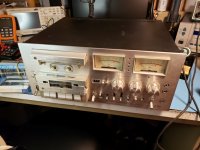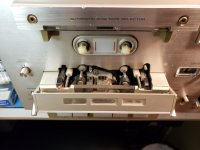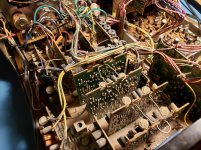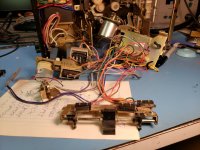So something over a month ago I was gifted a very broken but decent appearing Pioneer CT-F1000 dual capstan, dual motor, 3 head cassette deck. These machines were built and sold in the 1978 - 1979 time frame.
This machine appears to be a U.S. Military PX version since it has multi-voltage and matches the configuration shown for those machines. These machines retailed new in the 1978 - 1979 time frame for about $650 which was more than I could afford at the time. (I purchased a JVC KD-75 in 1977 while in college, and that was quite a stretch for me at something like $450 - that deck was still running well when my ex deprived me of it in 1999.)
They are an interesting mix of discrete and and integrated circuits. There are a lot of electrolytic capacitors to replace, and mechanical issues in the transport to address.
I actually got started on this at the beginning of September, and was not going to write about the odyssey, but I spend a lot of time these days trying to find meaningful things to fill my time so I have decided to try and share this project with the few who might be interested.
I have overhauled 4 different Otari R2R over the past 18 months or so and thought after a 20 year hiatus from cassettes that fixing one of the better examples of a cassette deck might be entertaining. The other part of the motivation is a rather large collection cassettes that my wife amassed in the 1990s and early 2000s that have been well stored - and for which there is no functional playback device.
This deck is one I would recommend all but the most intrepid pass by, it's not an easy machine to work on, and parts are not readily available.
This machine appears to be a U.S. Military PX version since it has multi-voltage and matches the configuration shown for those machines. These machines retailed new in the 1978 - 1979 time frame for about $650 which was more than I could afford at the time. (I purchased a JVC KD-75 in 1977 while in college, and that was quite a stretch for me at something like $450 - that deck was still running well when my ex deprived me of it in 1999.)
They are an interesting mix of discrete and and integrated circuits. There are a lot of electrolytic capacitors to replace, and mechanical issues in the transport to address.
I actually got started on this at the beginning of September, and was not going to write about the odyssey, but I spend a lot of time these days trying to find meaningful things to fill my time so I have decided to try and share this project with the few who might be interested.
I have overhauled 4 different Otari R2R over the past 18 months or so and thought after a 20 year hiatus from cassettes that fixing one of the better examples of a cassette deck might be entertaining. The other part of the motivation is a rather large collection cassettes that my wife amassed in the 1990s and early 2000s that have been well stored - and for which there is no functional playback device.
This deck is one I would recommend all but the most intrepid pass by, it's not an easy machine to work on, and parts are not readily available.
Attachments
This machine has bad belts, a bad FF/RWD clutch, bad micro-switches, and motors with dried out bearing front bearings.
It also has over 160 electrolytic capacitors, all of which need to be replaced. (I have replaced 34 to date.)
Since it basically refused to play except after considerable coaxing I decided the first order of business was to dismantle the deck to the point where I could access the transport.
I checked all of the micro-switches and jumpered the capstan motor switch which allowed it to run.
I observed that the fast forward and rewind were not working but the motor was.
The belts were all sloppy and loose. I immediately ordered replacements.
I noted that the FF/RWD clutch basically did not want to turn. These clutches are prone to internal cracking which results in them jamming and refusing to turn - mine was not there (yet), but was binding for some reason. Turned out the clutch had sat long enough for the clutch felts to stick to the plastic. Cleaned things up a bit and the clutch worked, but concerned about eventual failure I sent the clutch to markthefixer on audiokarma for his repair.
It also has over 160 electrolytic capacitors, all of which need to be replaced. (I have replaced 34 to date.)
Since it basically refused to play except after considerable coaxing I decided the first order of business was to dismantle the deck to the point where I could access the transport.
I checked all of the micro-switches and jumpered the capstan motor switch which allowed it to run.
I observed that the fast forward and rewind were not working but the motor was.
The belts were all sloppy and loose. I immediately ordered replacements.
I noted that the FF/RWD clutch basically did not want to turn. These clutches are prone to internal cracking which results in them jamming and refusing to turn - mine was not there (yet), but was binding for some reason. Turned out the clutch had sat long enough for the clutch felts to stick to the plastic. Cleaned things up a bit and the clutch worked, but concerned about eventual failure I sent the clutch to markthefixer on audiokarma for his repair.
Attachments
-
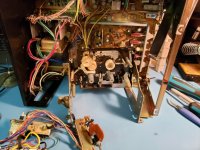 20200904_172103.jpg187.7 KB · Views: 561
20200904_172103.jpg187.7 KB · Views: 561 -
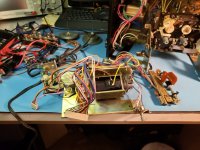 20200904_172100.jpg174.9 KB · Views: 490
20200904_172100.jpg174.9 KB · Views: 490 -
 20200904_165737.jpg185.2 KB · Views: 886
20200904_165737.jpg185.2 KB · Views: 886 -
 20200904_164904.jpg120.2 KB · Views: 498
20200904_164904.jpg120.2 KB · Views: 498 -
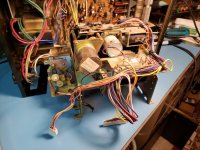 20200904_163816.jpg181 KB · Views: 1,073
20200904_163816.jpg181 KB · Views: 1,073 -
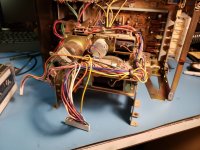 20200904_163649.jpg158.5 KB · Views: 488
20200904_163649.jpg158.5 KB · Views: 488 -
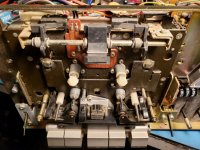 20200904_163244.jpg189.2 KB · Views: 676
20200904_163244.jpg189.2 KB · Views: 676 -
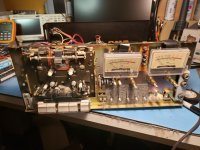 20200904_163227.jpg158.5 KB · Views: 707
20200904_163227.jpg158.5 KB · Views: 707 -
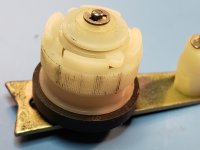 20200904_224340.jpg98.5 KB · Views: 728
20200904_224340.jpg98.5 KB · Views: 728
The tire on the clutch was cracked in two places so I ended up ordering some square profile O-rings which arrived a couple of days ago.
The clutch should be on its way back here from its repair.. The O-ring seems to be the correct size, but is slick enough I am not sure it is going to work. I have a lot of them so I will try roughing up the surface.
I lubricated the front motor bearings, based on prior experience I will not open up these motors to get at the rear bearings - it usually does not end well, and for some reason they have generally been OK.
Since the transport was out I took the opportunity to remove the logic board and re-cap it. By the same token I also recapped the PSU.
I still have 12 PCB assemblies to recap..
I also replaced all three micro-switches on the transport with ones purchased from Mouser.
The clutch should be on its way back here from its repair.. The O-ring seems to be the correct size, but is slick enough I am not sure it is going to work. I have a lot of them so I will try roughing up the surface.
I lubricated the front motor bearings, based on prior experience I will not open up these motors to get at the rear bearings - it usually does not end well, and for some reason they have generally been OK.
Since the transport was out I took the opportunity to remove the logic board and re-cap it. By the same token I also recapped the PSU.
I still have 12 PCB assemblies to recap..
I also replaced all three micro-switches on the transport with ones purchased from Mouser.
Attachments
-
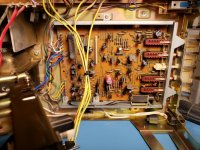 20200904_201934.jpg200.8 KB · Views: 284
20200904_201934.jpg200.8 KB · Views: 284 -
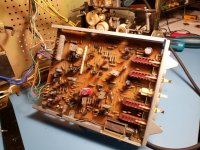 20200904_201138.jpg192.9 KB · Views: 272
20200904_201138.jpg192.9 KB · Views: 272 -
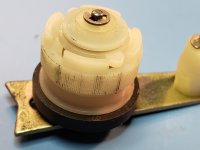 20200904_224340.jpg98.5 KB · Views: 313
20200904_224340.jpg98.5 KB · Views: 313 -
 20200912_205948.jpg168.2 KB · Views: 290
20200912_205948.jpg168.2 KB · Views: 290 -
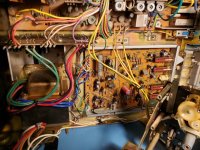 20200912_201031.jpg216.3 KB · Views: 470
20200912_201031.jpg216.3 KB · Views: 470 -
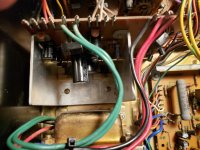 20200912_201024.jpg165.5 KB · Views: 276
20200912_201024.jpg165.5 KB · Views: 276 -
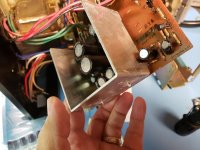 20200912_191655.jpg134.6 KB · Views: 242
20200912_191655.jpg134.6 KB · Views: 242 -
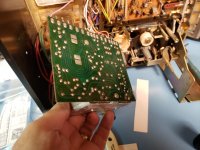 20200912_191649.jpg154.2 KB · Views: 263
20200912_191649.jpg154.2 KB · Views: 263 -
Page 11_optimize.pdf1.6 MB · Views: 163
-
Page 12_optimize.pdf717.4 KB · Views: 131
The service manuals for this deck are available on hifi-engine.
Belts and the idler drive tire are available here: Pioneer CT-F1000 Belt Kit
Belts, idlers, pulleys from: WJOE Radio
(This includes a replacement drive pulley for the FF/RWD motor and tires that appear to be of a suitable size for the clutch)
Clutch rebuilds by markthefixer who you can reach via audiokarma.
Belts and the idler drive tire are available here: Pioneer CT-F1000 Belt Kit
Belts, idlers, pulleys from: WJOE Radio
(This includes a replacement drive pulley for the FF/RWD motor and tires that appear to be of a suitable size for the clutch)
Clutch rebuilds by markthefixer who you can reach via audiokarma.
Power supply rebuild.. Since everything was basically working I just replaced the electrolytic capacitors.
The original circuit values are all available from Mouser, including what I thought was a rather oddball 1500uF 35V input filter capacitor value. Turns out there are lots of choices.
For these sorts of replacements I tend to go with industrial temperature range parts from Nichicon, Panasonic or Wurth..
For the audio capacitors yet to come I am likely to go with Nichicon Muse or Elna Silmic types. Nothing terribly exotic and purchased directly from Mouser or DigiKey.
I replace just one capacitor at a time and because electrolytics capacitors have changed so much from the 1970s I made no particular effort to try and match the lead spacings of the originals, were possible I got as close as I could, otherwise I just form the leads. Modern capacitors are much more compact than the originals in this deck.
I am using solder wick (chemtronics soder wick brand) to wick out the solder before removing the capacitors. This works great except for the few caps which are glued down making it hard to tell whether the capacitor is free or not. The lands on these phenolic PCB are a little fragile and some care is required. I have lifted 2 pads total on the 34 I have replaced so far.
I've just ordered a drive pulley from WJOE and an alternative tire for the clutch which is probably what I should have gotten in the first place and saved myself a whole lot of moola, but I did not know about WJOE when I ordered those.. Turns out WJOE is about 60 miles from here in MA.
The original circuit values are all available from Mouser, including what I thought was a rather oddball 1500uF 35V input filter capacitor value. Turns out there are lots of choices.
For these sorts of replacements I tend to go with industrial temperature range parts from Nichicon, Panasonic or Wurth..
For the audio capacitors yet to come I am likely to go with Nichicon Muse or Elna Silmic types. Nothing terribly exotic and purchased directly from Mouser or DigiKey.
I replace just one capacitor at a time and because electrolytics capacitors have changed so much from the 1970s I made no particular effort to try and match the lead spacings of the originals, were possible I got as close as I could, otherwise I just form the leads. Modern capacitors are much more compact than the originals in this deck.
I am using solder wick (chemtronics soder wick brand) to wick out the solder before removing the capacitors. This works great except for the few caps which are glued down making it hard to tell whether the capacitor is free or not. The lands on these phenolic PCB are a little fragile and some care is required. I have lifted 2 pads total on the 34 I have replaced so far.
I've just ordered a drive pulley from WJOE and an alternative tire for the clutch which is probably what I should have gotten in the first place and saved myself a whole lot of moola, but I did not know about WJOE when I ordered those.. Turns out WJOE is about 60 miles from here in MA.
Attachments
I have a CT-F1250 which had similar problems with the transport.
It sounds terrible! Very dull sound! Cannot see any wear on the heads. Suspecting there may be some bad caps in the circuit.
The plan is to feed some signal to it and trace it with a scope. Task for long cold winter evenings🙂
How was the sound from your unit?
It sounds terrible! Very dull sound! Cannot see any wear on the heads. Suspecting there may be some bad caps in the circuit.
The plan is to feed some signal to it and trace it with a scope. Task for long cold winter evenings🙂
How was the sound from your unit?
You should have started with a more modern Pioneer starting with CT-777...CT 95 S or CT-F1100 being the best of them.Much easier to service and better overall .Some say that the CT95 is better than the best Nakamichi ... Pioneer also tried something really special the CT W606 and w616 which have the first digital noise filter i have the 606.If that would have been a 3 head machine it would have been almost impossible to beat .Plus digital noise removing systems improved over time exponentialy. I have the CT707, i had the Nak Cr4 and also have the CT w606 plumany other decks, but i wouldn't buy a ct f1250 or f1000 , unless it's working and cheap, very cheap...The 70's generation of decks were't really great honestly.They were heavy though...
Last edited:
Sorry, I've my own nightmares - Tandberg TCD-420A, which works fine, and a TCD-440A which
the reel motors stop working when the front cover is put on.
Both need re-capping, but the boards are not easy to pull out.
the reel motors stop working when the front cover is put on.
Both need re-capping, but the boards are not easy to pull out.
I think the modern Pioneer are the most serviceable decks except their machanics.All Pioneer transports are pure nightmare although Pioneer plus Siemens made te ASAI factory that built the Tandberg 3014 and Dual c844 transport...few people really know about the Siemens involvement in some of the best tapedecks.
Tapeheads Tape, Audio and Music Forums - View Single Post - Pioneer CT-95 / T-1100S up close and personal
Tapeheads Tape, Audio and Music Forums - View Single Post - Pioneer CT-95 / T-1100S up close and personal
Why not? I ran one day my favorit cd player through the Pioneer ct-777 and dolby C on and i was amazed...I was almost crying .I can't imagine what a wonderful experience is running a digital sound thorugh a professional reel to reel...as i didn't have that experience yet, but a simple cassetet deck could make a brutal swing in my moods.
The CT-F1000 was a gift and I have received a lot of warnings about wasting my time resurrecting it. It wasn't able to play when I got it so I have no idea how it sounds..
This is mostly a project to fill up some free time and have a little fun, if it plays our pre-recorded tapes and can record on the few samples of antique TDK SA I have and sound OK, it's mission accomplished.
I have 3 Otari 15ips machines and I don't expect this to come anywhere close to them, nor indeed are they the last word in transparency either. (Although a full recap and in one case some rather major mods has resulted in some improvement.)
I actually use them to play tapes, the fact that they are not completely transparent is obvious, and I'm not really interested in effects boxes. What I am interested in is a good technical challenge, a good end result is hoped for but not taken for granted.
And I am retiring in a few years and there are people who collect audio anachronisms - if I can make a little money bringing these things back from the dead as well as delay the onset of mental atrophy then this is all to the good.
This is mostly a project to fill up some free time and have a little fun, if it plays our pre-recorded tapes and can record on the few samples of antique TDK SA I have and sound OK, it's mission accomplished.
I have 3 Otari 15ips machines and I don't expect this to come anywhere close to them, nor indeed are they the last word in transparency either. (Although a full recap and in one case some rather major mods has resulted in some improvement.)
I actually use them to play tapes, the fact that they are not completely transparent is obvious, and I'm not really interested in effects boxes. What I am interested in is a good technical challenge, a good end result is hoped for but not taken for granted.
And I am retiring in a few years and there are people who collect audio anachronisms - if I can make a little money bringing these things back from the dead as well as delay the onset of mental atrophy then this is all to the good.
Have You measured Wow & Flutter ?
My restored CT-606 measures between .1 & .2, but the service manual says .06 %
I believe they are talking about the motor only.
Belts came from a German Ebay seller since Marrs Communications don't accept Paypal.
Apparently new felt & white non Yelloish clutches I could find on an Hungarian Shop which didn't speak anything besides Hungarian.
I did align & calibrate it using a test tape with Daqarta. Very useful for speed & azimuth check. Don't trust Your ears. Didn't touch the Dolby alignment, since I've never used it.
Played & recorded a few tapes and it plays wonderful. Planning a recap soon.
I have also bolted the transformer to the backside of the chassis since in that rotated position the quasi un-noticeable hum when playing without tape went away.
My restored CT-606 measures between .1 & .2, but the service manual says .06 %
I believe they are talking about the motor only.
Belts came from a German Ebay seller since Marrs Communications don't accept Paypal.
Apparently new felt & white non Yelloish clutches I could find on an Hungarian Shop which didn't speak anything besides Hungarian.
I did align & calibrate it using a test tape with Daqarta. Very useful for speed & azimuth check. Don't trust Your ears. Didn't touch the Dolby alignment, since I've never used it.
Played & recorded a few tapes and it plays wonderful. Planning a recap soon.
I have also bolted the transformer to the backside of the chassis since in that rotated position the quasi un-noticeable hum when playing without tape went away.
Most Japanese made cassette decks the wow & flutter was measured and specified as an RMS measurement, DIN measurements IIRC are peak and will generally be higher.. You didn't specify which measurement you are using.
My deck was not and is not in running order and won't be for a while yet. I am still awaiting a fairly large number of parts to arrive.
If you look at the photo of the transport chassis you will notice that a lot of components like the motors, capstans, belts, clutch, some linkages and other stuff is missing.
The second photo is of some of the bits I have been working on, there are new switches and the front bearings of the motors have been lubricated.
I am weeks if not months away from having a running machine.
My deck was not and is not in running order and won't be for a while yet. I am still awaiting a fairly large number of parts to arrive.
If you look at the photo of the transport chassis you will notice that a lot of components like the motors, capstans, belts, clutch, some linkages and other stuff is missing.
The second photo is of some of the bits I have been working on, there are new switches and the front bearings of the motors have been lubricated.
I am weeks if not months away from having a running machine.
Attachments
I have a CT-F1250 which had similar problems with the transport.
It sounds terrible! Very dull sound! Cannot see any wear on the heads. Suspecting there may be some bad caps in the circuit.
The plan is to feed some signal to it and trace it with a scope. Task for long cold winter evenings🙂
How was the sound from your unit?
Mine was almost dead when I got it, consequently I did not get to listen to it.
I don't plan to do any serious trouble shooting until after I recap it, after overhauling 4 Otari R2R it's pretty clear a lot of problems in vintage machines are caused by bad capacitors (provided the machines went to their long sleep in running order) so I don't waste my time and trouble shoot only after - in most cases they run correctly once recapped. I have run into some interesting problems which would have been needlessly complicated by bad parts.
The logic board and PSU both were working fine before the tear down, and I have recapped them since they are inaccessible with the transport in place.
I have a CT-F750. I replaced the belts as they were very loose. I re-dressed the mains input wiring and re-capped the power supply, and have cleaned and lubricated some of the mechanical parts. I'm curious to see what you find necessary to fix, and how.
No one here ever tinker with or own one of these decks? 😀 Just curious to hear.
Well, I don't "tinker" actually, but I did overhaul a Pioneer CT-F950 about 3 years ago for a customer.
Brought it back to spec and it'll live a few decades I suppose.
It was....... fun (not!)
The Technics RS-1500US reel to reel on the bench now has to be shelved, at least for now.
I gotta tell the customer that it needs head(s)
The 2 track playback head is toast.
Last edited:
- Home
- Source & Line
- Analogue Source
- So you think you want to play with tape: The Pioneer CT-F1000 3 Head Cassette Deck
